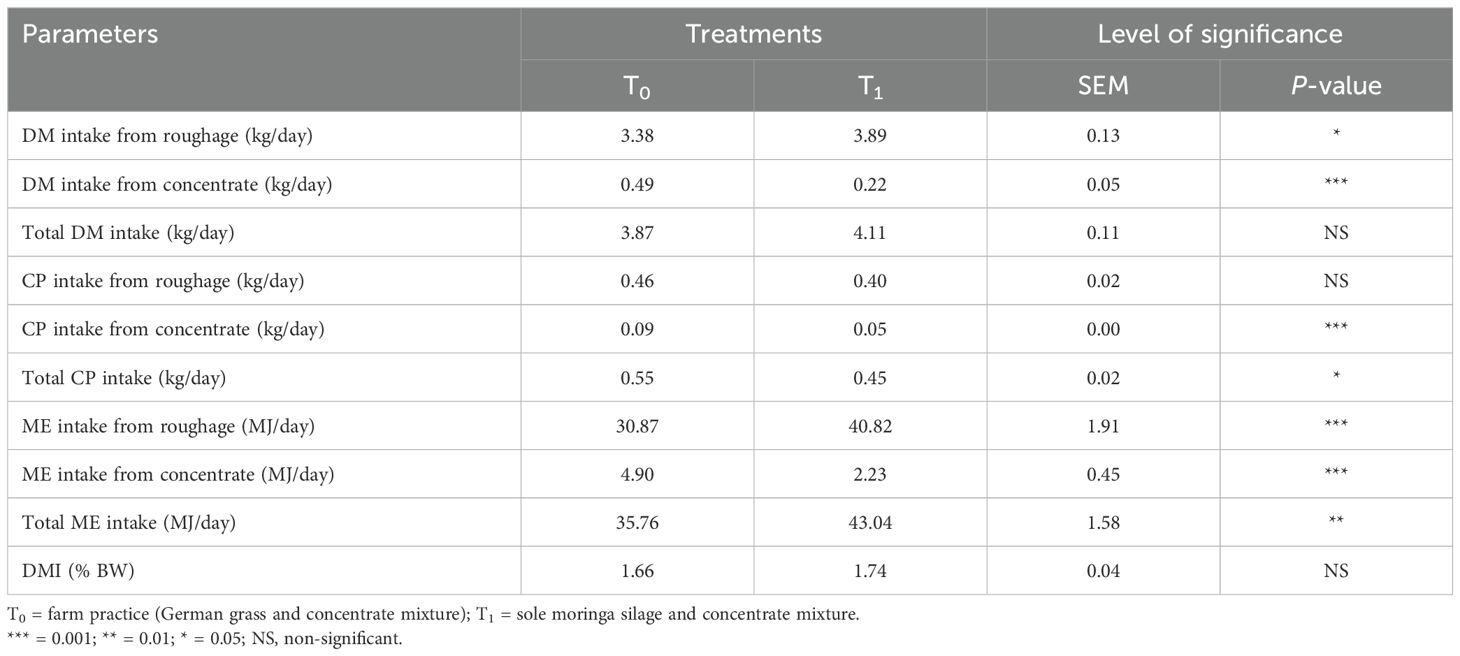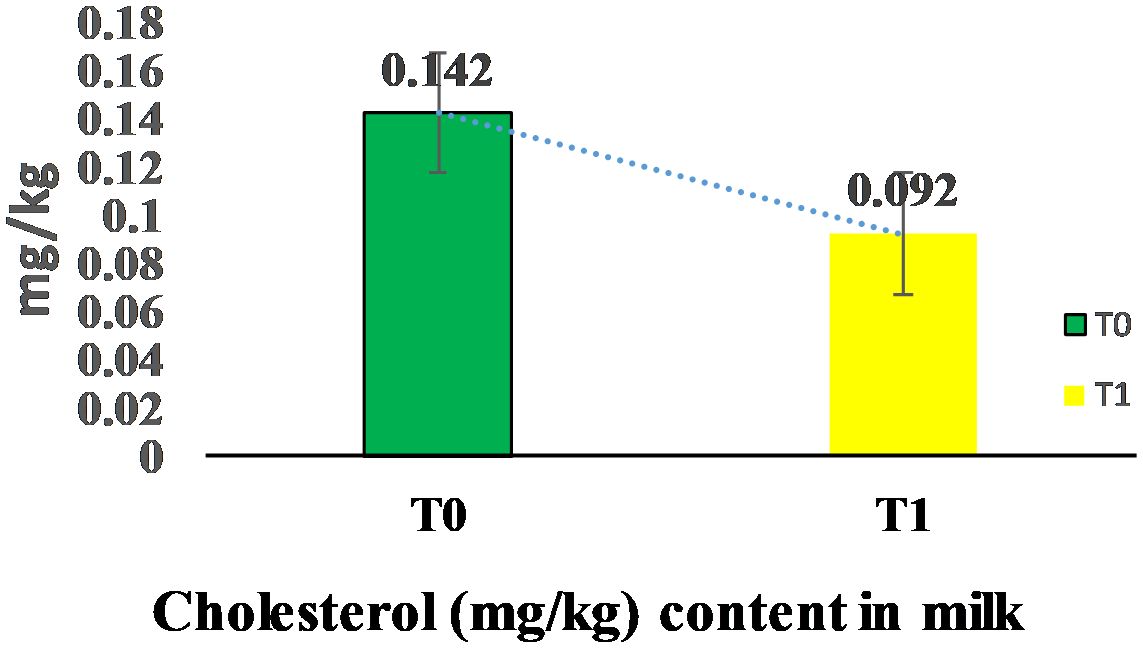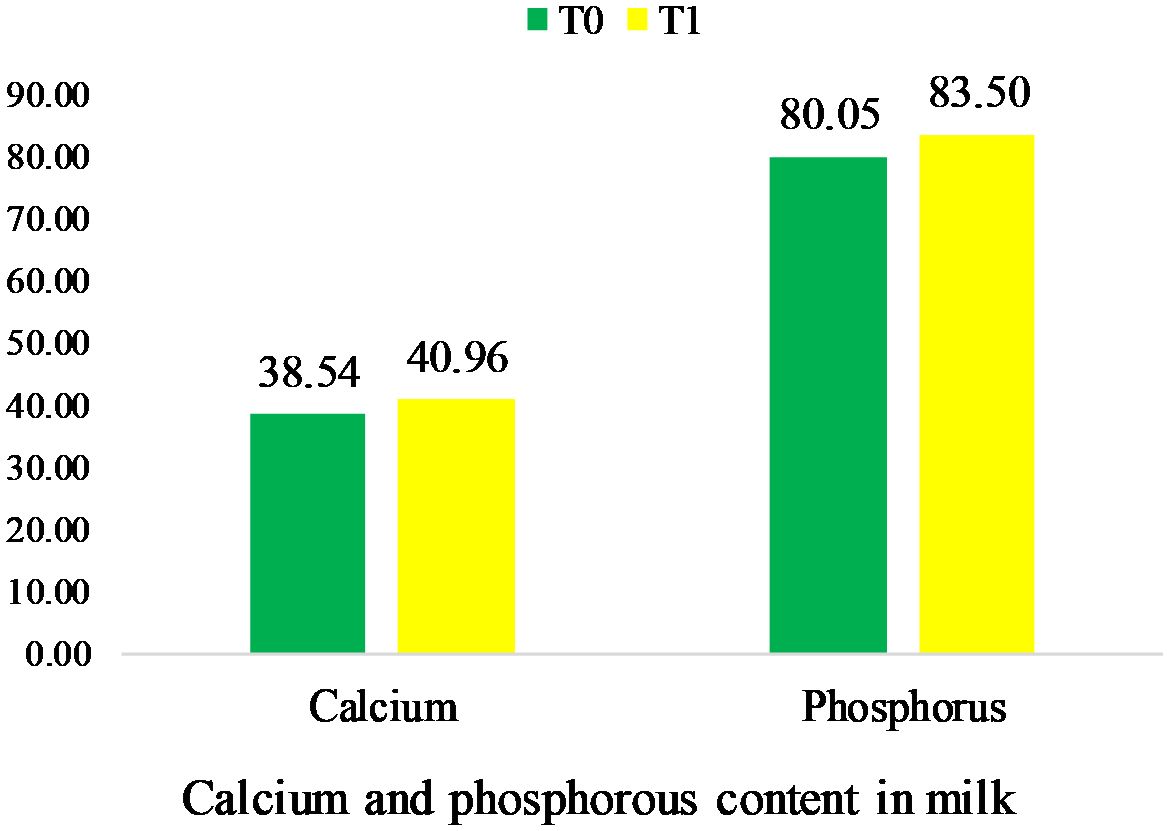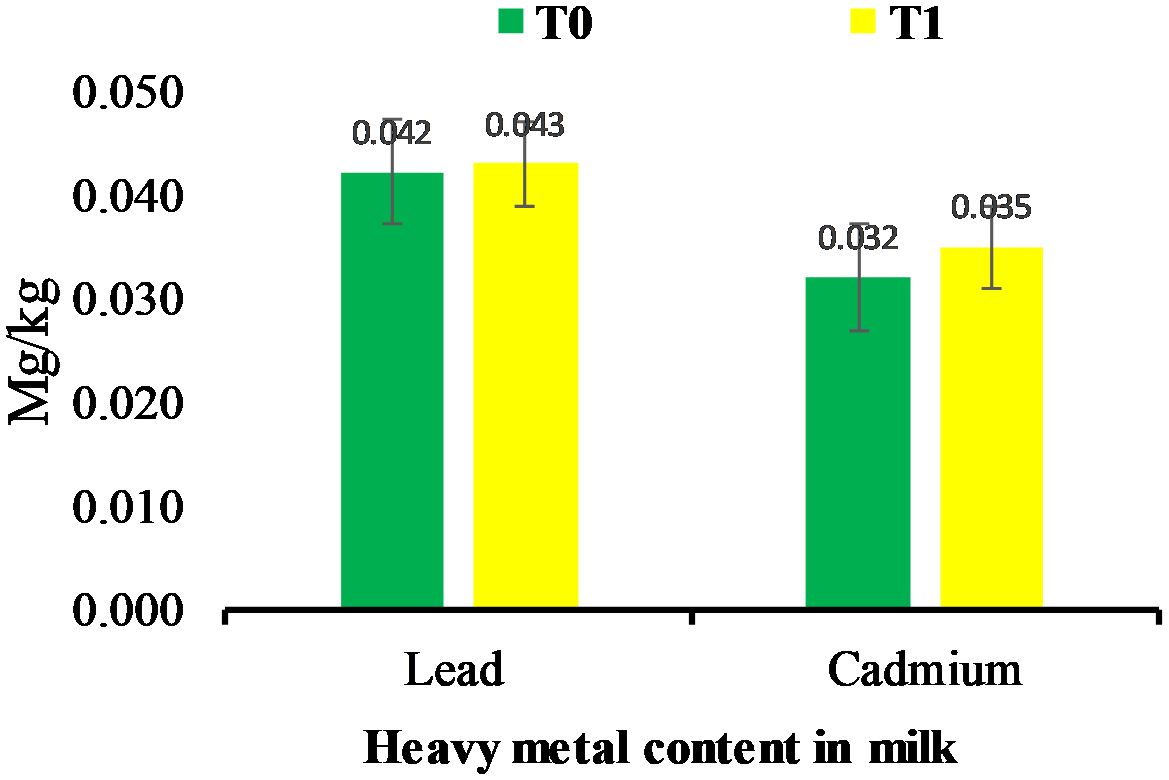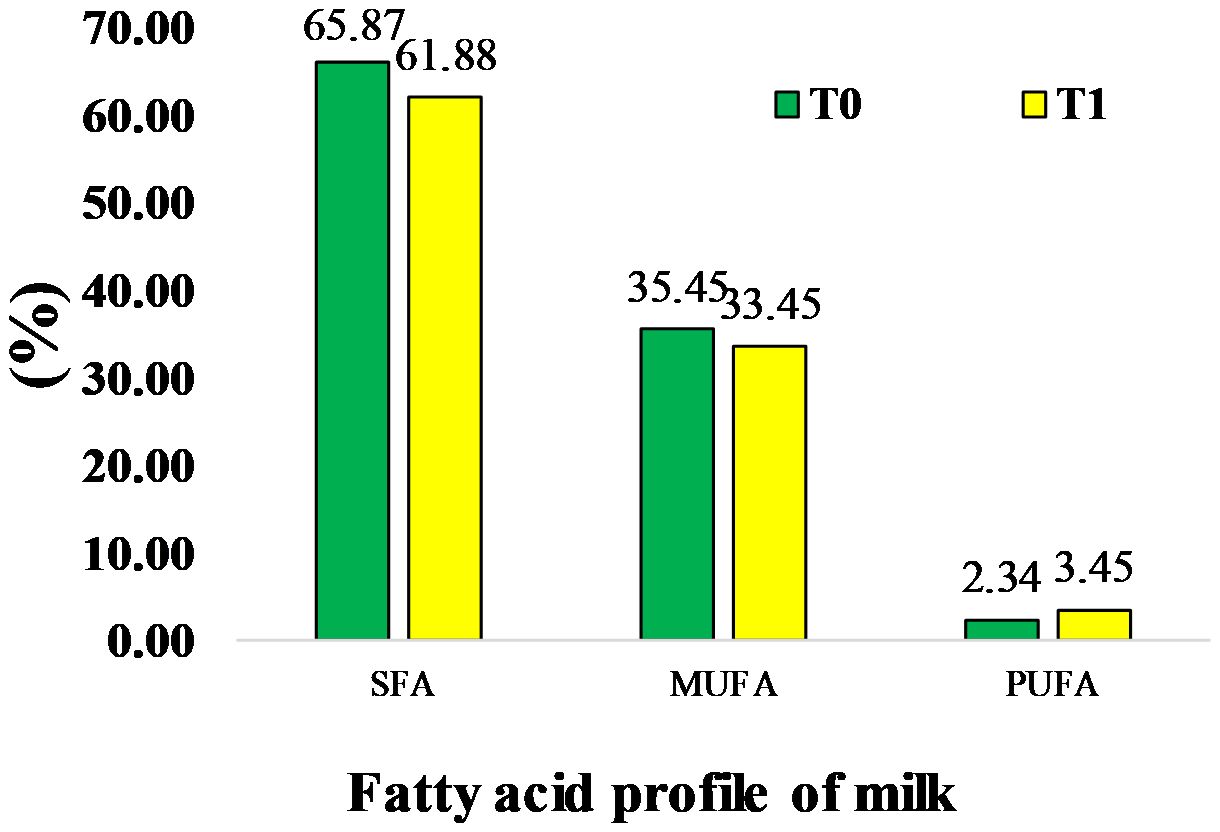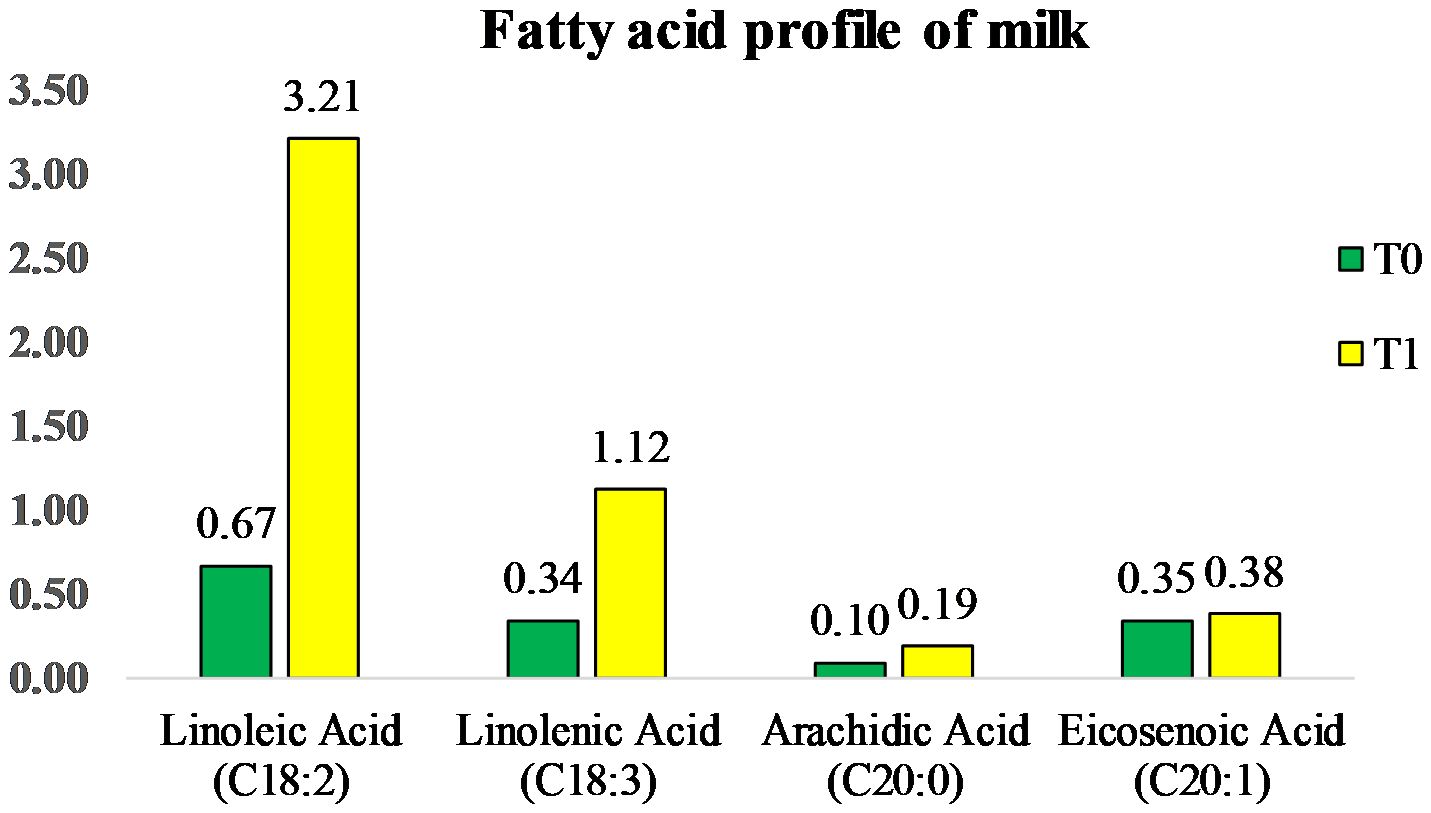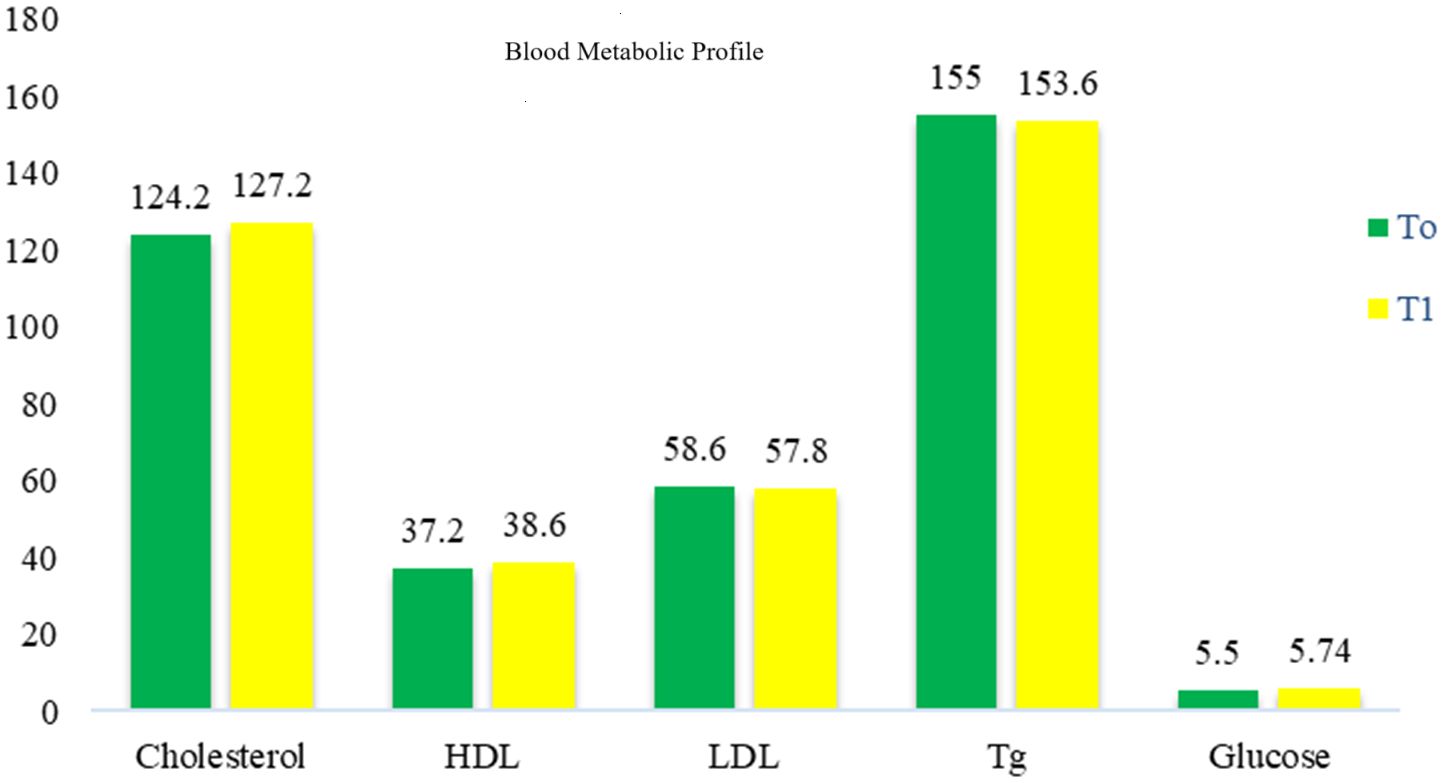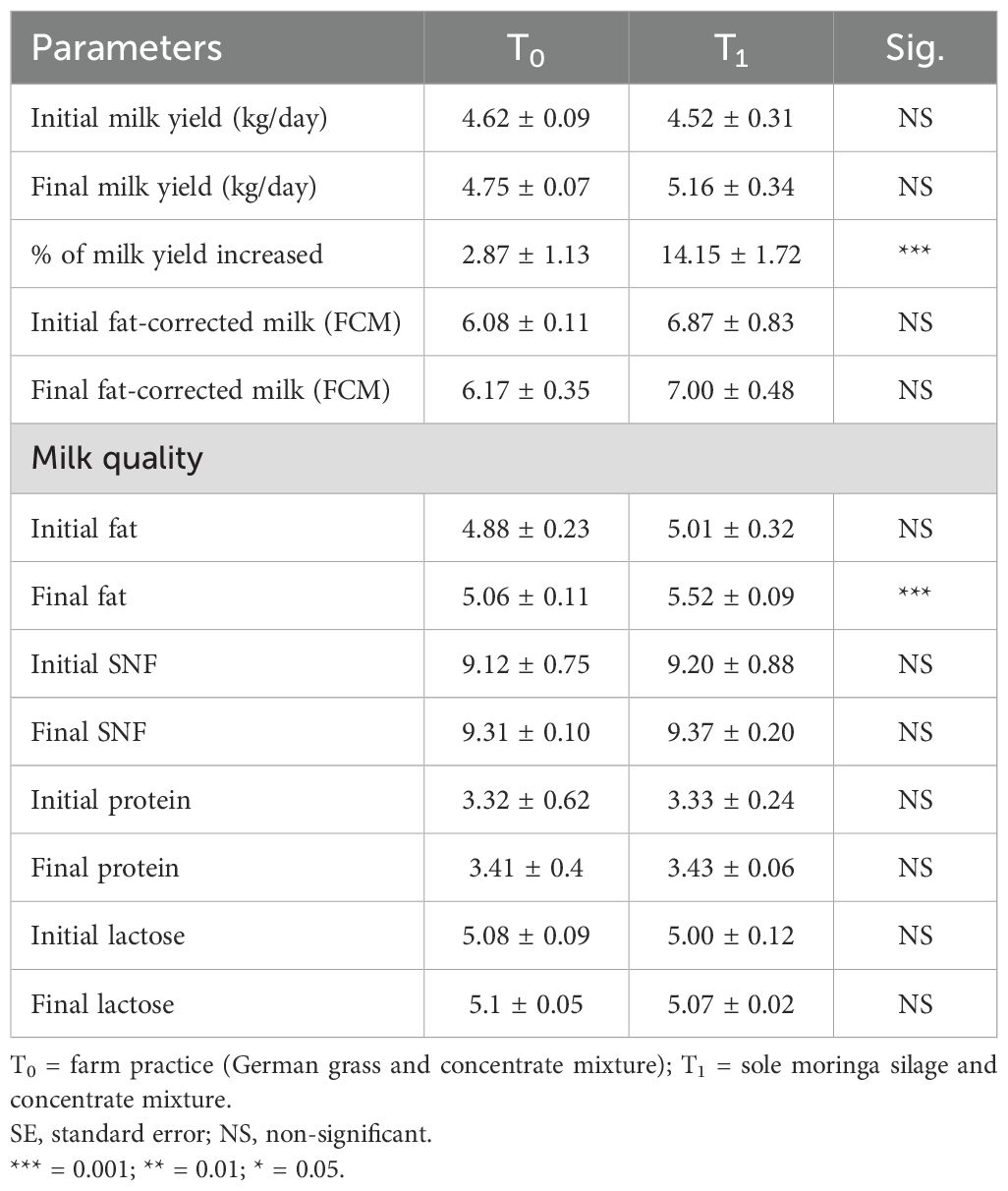- 1Office of Director (Research), Bangladesh Livestock Research Institute, Savar, Dhaka, Bangladesh
- 2Biotechnology Division, Bangladesh Livestock Research Institute, Dhaka, Bangladesh
- 3Buffalo Production Research Division, Bangladesh Livestock Research Institute, Dhaka, Bangladesh
This experiment aimed to evaluate the biomass yield, nutritional composition, preservation techniques of Moringa oleifera, and the effect of M. oleifera silage on the milk production and quality of local Red Chittagong cattle (RCC). Four varieties of M. oleifera were planted, cultivated, and harvested on the Bangladesh Livestock Research Institute (BLRI) research farm. The findings revealed the highest biomass yield in Paraynal varieties (11.24 ± 0.41 tons/ha/year) compared to others. The maximum DM percentage was found in PKM-2 (21.85 ± 1.65) followed by the PKM-1 (21.38 ± 1.98), Paraynal (20.17 ± 2.35), and Black (17.81 ± 1.28) varieties. The study observed greater crude protein (CP) percentage in Black varieties (18.07 ± 0.18) compared to other varieties. A feeding trial was conducted on 10 RCC native dairy cows. Two groups were considered: one was the control (T0) group fed the German grass and concentrate mixture, and the other was the treatment (T1) group fed the moringa silage and concentrate mixture. Each group consisted of five lactating RCC. Moringa oleifera was collected from the BLRI research farm and chopped for silage preparation. The pH of moringa silage was 4.07 ± 0.02, which ensured good quality. There was no significant difference in total DM intake, but the total CP intake (0.55 kg/day) was significantly higher in the control group and the total ME intake was significantly higher in the treatment group compared to the other group. The T1 group increased milk yield by approximately 14.2%. Milk composition was not significantly (P > 0.05) different between the two groups, whereas milk fat significantly differed. Milk fat was slightly higher in the T1 group and the difference between the groups was 0.46%. Moringa silage increased PUFA, linoleic acid (C18:2), linolenic acid (C18:3), arachidonic acid (C20:0), and eicosapentaenoic acid (C20:1) and decreased SFA and MUFA in milk. It was concluded that moringa silage feeding will be a good source of nutrients for livestock to maintain their good health and productivity.
Introduction
Dairy cows and other ruminants depend heavily on forages as their feed. Because of their physical and chemical properties, they are the main source of fiber for ruminants, which has a substantial impact on the ruminal ecosystem and nutrient digestibility (Koakoski et al., 2024). The low productivity of livestock in most tropical countries, including Bangladesh, is due to feed shortages and non-availability of quality feed. In most tropical countries, the livestock feeding system is mostly based on crop residues with low nutritional status and poor digestibility (Babeker and Bdalbagi, 2015). Low-quality roughage such as rice straw, roadside grasses, and naturally grown grass in agricultural and fallow land is the most common source of roughage for livestock in Bangladesh. The major concentrate sources are agricultural products and the by-products of grains, cereals, legumes, etc. However, most of the grains and cereals are imported from foreign countries for human consumption, and there is increasing competition between humans and livestock for these feed ingredients as food. Additionally, the involvement of middlemen in this process ultimately increases the price, although availability is frequently unpredictable for these types of concentrates. As a result, concentrate feeds, especially protein sources, are always considered expensive for livestock in Bangladesh.
Furthermore, protein supplementation to balance other nutrients available in the feed addressing the animal’s requirements is essential to increasing livestock productivity (Babeker and Bdalbagi, 2015). The human and livestock populations are growing rapidly in Bangladesh, which propelled the increasing demand for food and feed. Therefore, it is indispensable to search for alternative feed resources, especially unconventional feeds, that may have valuable components in animal diets. According to Sultana et al. (2021), in many tropical and subtropical regions, the utilization of parts of a tree as alternative feed resources for ruminant livestock is considered important and also becoming popular. To produce environmentally and economically sustainable fodder and lower greenhouse gas emissions, scientists have worked hard to find ways to use agricultural by-products, tree leaves, and plant leaves to change the composition of feed and give sufficient nutrients. Because tree leaves often have a higher nutritional value than grasses and are more appealing to herbivores, using them as feed ingredients is a successful mitigating approach (Bryant et al., 2014).
Research indicates that moringa leaves are rich in proteins, vitamins, and minerals, making them an excellent addition to animal diets (Sultana et al., 2021; Akintunde et al., 2024). Additionally, moringa has been found to positively influence the health and productivity of ruminants, with benefits including improved milk yield and better overall health (Su and Chen, 2020; Gafer et al., 2023). It also reduces methane emissions, making it a sustainable feed option (Amad and Zentek, 2023). Due to its exceptional nutritional value and potential positive aspects for livestock, moringa is gaining recognition as an effective feed supplement (Rizwan et al., 2022). As Moringa oleifera leaves are high in protein and minerals and produce much forage, they can be used to feed dairy cows during the dry season when there is a shortage of forage ( (Foidl et al., 2001; Pankajakshan and Arunima, 2020). Interestingly, every part of the M. oleifera plant, including the leaf, root, bark, seed, flower, and pod, is edible and contains compounds that are important for human and livestock wellness (Kadhim and AL-Shammaa, 2014). Research indicates that moringa can achieve significant biomass production under optimal conditions, with yields ranging from 10 to 20 tons per hectare annually, depending on factors such as soil quality, irrigation, and management practices (Huque et al., 2016; Ahmed et al., 2020). Moringa oleifera is noted for its high nutritional value, containing approximately 26% protein in dried leaves and essential vitamins, minerals, and phytochemicals (Akintunde et al., 2024). In Bangladesh, it contains 11%–34% protein, with its leaves having higher protein content than its pods, making them a valuable source of protein in the diet. Because of M. oleifera’s extensive nutritional, antioxidative, and medicinal qualities, researchers have been studying it more and more recently (Ndubuaku et al., 2015). The leaf of M. oleifera is rich in fatty acids, vitamins, minerals, and crude protein (Rockwood and Anderson, 2013; Gopalakrishnan et al., 2016). Moringa oleifera is fed to livestock in different forms, such as dried moringa, mash, direct moringa leaves, and moringa silage with other fodder. The preservation of green forages through acidification is a natural process that occurs once these forages are ensiled. The main advantage of this conservation strategy for farmers is that it significantly shortens the time needed to harvest forage, particularly in situations where forced drying of the feed is impractical (Koakoski et al., 2024).
However, some information was gathered about sole moringa silage in livestock feeding systems. Moringa silage can enhance milk production and improve the nutritional quality of milk due to its rich protein and mineral content. Additionally, it has been observed that moringa silage can positively influence the overall feed intake and digestibility, leading to better growth rates in dairy cattle (Alarape et al., 2023). However, extensive research has not been done on diets consisting nearly solely of moringa silage for local dairy cows in Bangladesh. Therefore, this study was undertaken to examine the biomass yield, nutritional composition, preservation techniques of moringa, and the effect of moringa silage on the milk production and quality of local RCC.
Materials and methods
The experiment was conducted to assess the biomass yield, nutritional composition, preservation techniques of M. oleifera, and the effect of M. oleifera silage on milk production and quality of local Red Chittagong cattle. Red Chittagong, also known as RCC, is a breed of cattle native to Bangladesh. Locally, the breed is known as Lal Birish. The breed has mainly originated in the Chittagong District of southern Bangladesh. Red Chittagong is similar in most ways to the native or local cattle, except that its coats, as well as tongue, eyebrow, eyeball, eyelash, horns, hooves, vulva, and tail switch, are also red. Red Chittagong cattle are reddish in color and small in size with mature bulls and cows weighing 330 to 350 and 180 to 220 kg from birth weights of 16 and 14 kg, respectively. The offered feed types were generally low in nutritional value, especially crude protein, but in spite of the low mean levels of milk production (618 L over a 228-day lactation), there were high levels of milk protein (3.8%) and fat (4.8%).
Location of the experiment and agroclimatic conditions
This experiment was carried out at the research farm of the Bangladesh Livestock Research Institute (BLRI), Savar, Dhaka-1341. Moringa oleifera was planted and cultivated from August 2019 to August 2020. The experimental site was located at 23°89′0′′N, 90°27′9′′E at an altitude of 5 m above sea level. The research site belongs to the Madhupur Tract Agro-ecological Zone (AEZ-28) of Bangladesh. The physicochemical properties of the soil were analyzed before the start of the experiment using standard procedures. Soil samples were collected from a depth of 0–15 cm of the experimental field. The clayed textured soil of the station was strongly acidic (pH 4.5–5.7) containing very little (<1.5%) organic matter. The analytical data of the soil sample were collected from the experimental area which was determined in the Soil Resource Development Institute (SRDI), Soil Testing Laboratory, Khamarbari, Dhaka-1215. The climate of the experimental site is subtropical, characterized by heavy rainfall during the months from April to September (Kharif season) and scant rainfall during the rest of the year (Rabi season). The highest rainfall at the experimental site was in July at 373.1 mm and the lowest was in January at 7.7 mm during the period of the experiment. The average maximum and minimum temperatures were 33.7°C and 10.2°C, respectively, and humidity ranged from 37% to 74% during the experimental period. The maximum and minimum temperature, humidity, rainfall, and sunshine during the study period were collected from the Bangladesh Meteorological Department (climate division).
Pregermination treatment combination
The four varieties of M. oleifera seeds collected were soaked in tap water for 12 h. After that, the seeds were sown into a germination medium. Gunny bags and tissue paper were used as germination media. At first, one layer of gunny bag was placed, then it was soaked with water, and then two layers of tissue paper were placed over it. At that time, the soaked seeds were placed on it and covered with two layers of tissue paper and one layer of gunny bag. A watering cane was used to water the seeds regularly to keep the optimum moisture level to induce sprouting. After 3 days, the seeds sprouted and were ready for sowing into polybags.
Production of seedlings
The soil was collected from the research field of BLRI. All inert materials such as stones, bricks, and crop residues were removed from the soil. Then, manure was collected from the adjacent cow shed, and a mixture of manure and soil in the ratio of 1:2 was used as a germination medium for M. oleifera. The mixture of soil and manure was left for 7 days before being used as a germination medium. The prepared soil was filled into a 15-cm × 15-cm polybag. The polybags were filled with soil and cow manure mixtures. The pre-germinated seeds were placed into the polybags by making a hole. One seed per polybag was sown, and it was covered by soil. Germination percentage and survival rate were measured. Seedlings were watered regularly for the first month and at 2-day intervals for the second month. For watering the seedlings, a water splash was used to prevent the decay of the seed. After observing and caring for the seedlings, they were planted in the main field for further study.
Experimental layout, land preparation, and agronomical procedure
Selected land was prepared for planting the M. oleifera seedlings. The land was cleared manually to remove existing vegetation, and the soil was worked thoroughly to remove pebbles and hard objects. The prepared seedlings were transplanted into the main field. The experiment was laid out in a randomized complete block design (RCBD) with four replications of each variety. Total land was divided into four blocks; each block was again divided into four experimental subplots and the total plot number was 16. The size of each plot was 8 × 8 square feet, the plant-to-plant space was 1.5 × 1.5 cm, and the row-to-row distance was also 1.5 ×1.5 cm. Finally, plots were according to the treatment combination, which was ultimately used as a drain. Sixty-day-old M. oleifera seedlings were transplanted in the early morning into each subplot. The transplanting was done within 4 days in mid-October. The recommended spacing was maintained at the time of transplanting. The polybag containing the seedling was removed by using a sharp knife. The seedlings were placed in the pit and filled with extra soil. Sticking was done to support the seedlings. After planting the M. oleifera seedlings, watering was done as necessary.
Manuring and fertilization
A blanket dose of 10 tons/ha of cow manure, 150 kg/ha of nitrogen (N), 25 kg/ha of phosphorous (P), and 30 kg/ha of potash (K) was used in the entire season (Huque et al., 2016; Huque et al., 2017). All fertilizers were used in three installments. One part of the fertilizer was used during land preparation, the second part was used when the plants were initially established, and the third part was used after every harvesting period. A general application of cow manure at 262 kg/ha and 75 kg/ha, as well as a dose of nitrogen, was applied during the final land preparation. At the time of transplantation, 8.33 kg/ha of phosphorous and 10 kg/ha of potash were applied. The remaining fertilizers of nitrogen, phosphorus, and potash were used at 90 DAT and 180 DAT.
Development of preservation technique for M. oleifera silage
After planting, the first cutting was made 120 days later when the crop was 60 cm in height. Subsequent cuttings were continued after the first cutting at 40-day intervals. Fresh moringa was chopped 1.5 to 2.0 cm in length. Fresh chopped moringa was packed in a small air-tight plastic container. A total of 45 containers were filled with chopped fresh moringa, and a filled moringa container was opened at 7-day intervals after 21 days. All samples were taken and analyzed at the animal nutrition laboratory of the BLRI for proximate component and fiber analysis.
Management and feeding trial with local RCC
The feeding trial was conducted to study the impact of moringa silage on the milk production and quality of local RCC. The experiment was arranged with 10 lactating RCC with an average body weight of 200 ± 10 kg, average number of lactations equal to 3, average lactation length of 240±10 days, average milk yield of 4 to 6 L, and average body condition score (BCS) of 2.5, of which five RCC were considered as the control group (supplied feed in accordance to common farm practice) and five RCC were supplied sole moringa silage with concentrate mixture as a complete feed according to the requirement of the animal. The concentrate mixture was isonitrogenous feed for both groups, and the composition is presented in Table 1. Moringa silage was provided to the treatment group, while the control group was fed German grass (Echinochloa polystachya) previously harvested at the BLRI. German grass (E. polystachya) was supplied to the animals by chopping it 4 mm long. Daily required feed was divided into two parts: one part was supplied in the morning (8.00 h) and the other part was supplied in the afternoon (15.00 h). The animals were housed in a well-ventilated shed with individual concrete floor stalls fitted with individual feed and water troughs. The daily feed consumption was calculated through the conventional method of variance between supply and leftover. Before the feeding time, the feeds were weighted and kept in the feed trough. On the next day, in the morning, the leftovers were collected and weighed individually and written down into the data collection sheet before offering the new feed. The dry matter (DM) of the leftovers was determined at least once a week except for the period of digestibility determination. Supply and refusal of moringa silage and the tested ration were collected daily for sampling and stored in a freezer (−18°C). For proximate analysis, these collected samples were mixed to produce one sample of each cow. Hand milking was carried out twice a day, in the morning and evening. Every day, the total milk production per cow was weighed and noted, and every day 100 mL of milk was kept in the milk sample bottle for storage immediately in the refrigerator and maintained at 4°C. The milk sample of the whole day was mixed to make the sample homogeneous for the determination of milk composition. Milk samples were analyzed for fat, solid-non-fat, protein, lactose, and density using an automatic LactoScan LS-60 (Milkotronic Ltd., Bulgaria) milk analyzer.
Blood metabolic profile and macrominerals
Blood samples (10 mL) were taken twice a week in fasting condition from the jugular vein of each cattle into a clean dry EDTA tube, without anticoagulants for the measurement of blood chemistry. All blood serum samples were analyzed using an A15 Biosystem analyzer to determine the concentrations of blood metabolites. After centrifugation (4,000 r/min), blood plasma was separated within 15 min. Immediately, the blood sugar (BS) concentration was determined for the whole blood. Serum cholesterol, HDL, LDL, triglyceride, and glucose were also identified. Daily milk production was recorded and milk quality in terms of milk fat, protein, solid not fat (SNF), fatty acid profile, calcium, phosphorus, heavy metal, and cholesterol was analyzed.
Statistical analysis
One-way analysis of variance was used to determine the production performance and nutrient composition of different moringa varieties, the Duncan multiple range test was used to compare the mean values, and an independent samples t-test was used to observe the response of moringa silage on RCC through the statistical package for Social Sciences 11.5 software. Significance was declared at P <0.05.
Results
Biomass production of different Moringa oleifera varieties
A comparison of different moringa varieties on biomass yield (fresh and dry matter basis) and crude protein yield is shown in Table 2. The present study revealed that biomass yield significantly varied among the four varieties of moringa. The highest biomass yield of total foliage on a fresh basis was observed in Paraynal (11.24 ± 0.41 tons/ha/year) followed by PKM-1 (10.56 ± 0.65 tons/ha/year) and PKM-2 (9.88 ± 0.24 tons/ha/year).
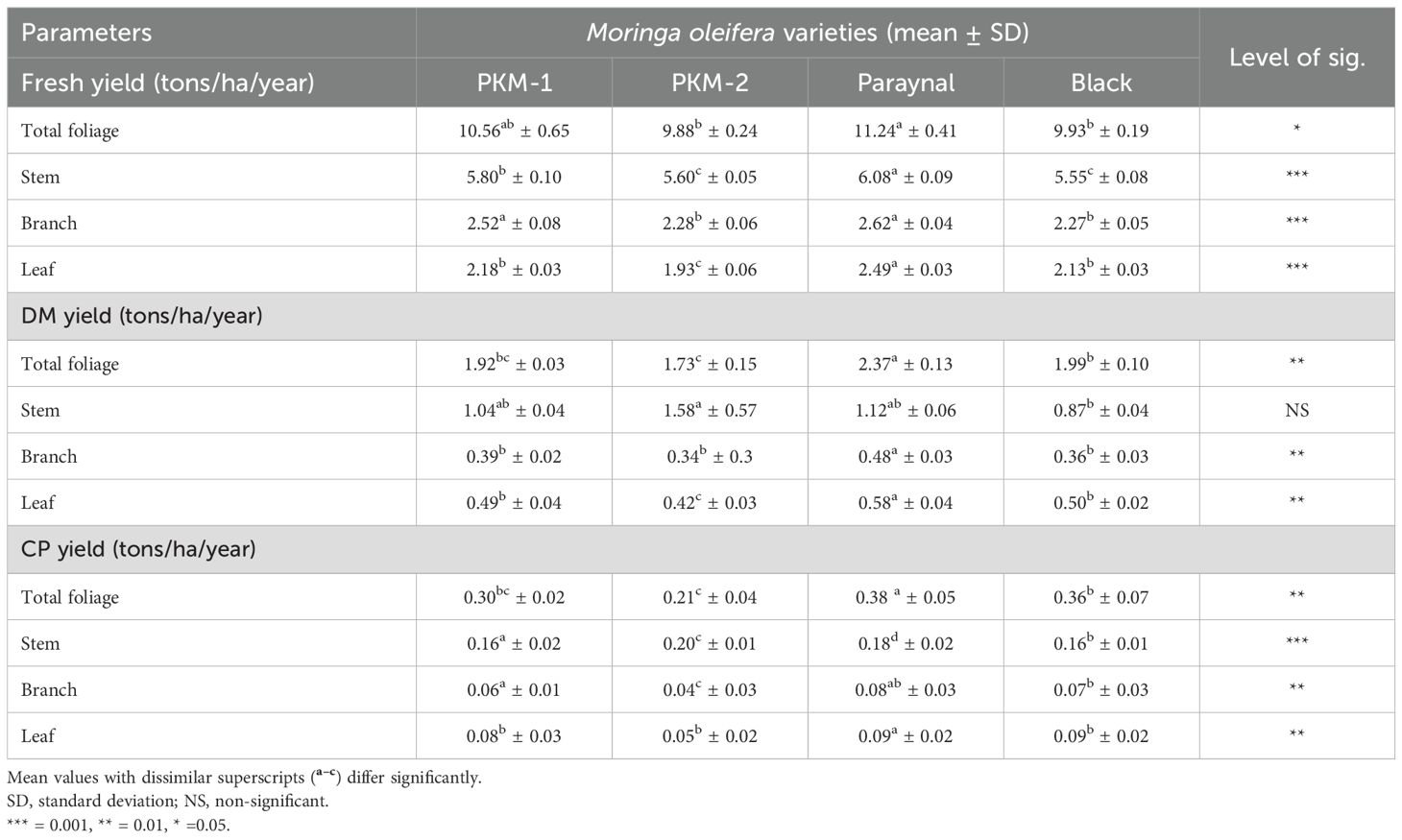
Table 2. Comparison of different moringa varieties on biomass yield (fresh and dry matter basis) and crude protein yield (cutting interval 40 days).
However, the lowest biomass yield was found in the Black seed (9.93 ± 0.19 tons/ha/year) moringa variety. Considering the biomass yield of total foliage on a dry matter basis, the highest yield was found in Paraynal (2.37 ± 0.13 tons/ha/year) followed by Black seed (1.99 ± 0.10 tons/ha/year) and PKM-1 (1.92 ± 0.03 tons/ha/year). The lowest biomass yield was found in PKM-2 (1.73 ± 0.15 tons/ha/year). There was a significant difference (P > 0.05) in biomass yield regarding branches and leaves on a dry matter basis. For the CP yield, there is a substantial variation among the different moringa varieties. The highest CP yield from the total foliage was found in Paraynal (0.38 ± 0.05 tons/ha/year) followed by Black (0.36 ± 0.07 tons/ha/year) and PKM-1 (0.30 ± 0.02 tons/ha/year), and the lowest CP yield was observed in PKM-2 (0.21 ± 0.04 tons/ha/year).
Nutritional composition of different Moringa oleifera varieties
A comparison of the nutritional composition (%) of different varieties of moringa is shown in Table 3. There was a significant difference in DM, ADF, NDF, and CP percentages among the different moringa varieties. The highest DM percentage was found in PKM-2 (21.85 ± 1.65) and PKM-1 (21.38 ± 1.98) followed by Paraynal (20.17 ± 2.35) and Black (17.81 ± 1.28).
In the case of ADF, the highest ADF percentage was found in PKM-2 (44.07 ± 1.83) followed by PKM-1 (42.91 ± 0.70) and Black (42.60 ± 1.05), and the lowest ADF was found in the Paraynal (41.12 ± 0.50) variety. The highest NDF percentage was observed in PKM-2 (55.65 ± 0.68) and Paraynal (54.53 ± 2.71) followed by the PKM-1 (50.59 ± 0.90) and Black (45.80 ± 1.27) varieties. A significant difference was also found in the CP content of the varieties. The highest CP percentage was revealed in Black (18.07 ± 0.18) followed by Paraynal (16.01 ± 0.95) and PKM-1 (15.55 ± 0.10), and the lowest CP percentage was found in the PKM-2 (12.40 ± 0.23) variety. There was no significant variation observed in the ash content of the four varieties of moringa.
Organoleptic characteristics of Moringa oleifera silage
The physical properties of moringa silage were observed in this experiment. The acidity of moringa silage was 4.07 ± 0.02, which increased the fermentation of the moringa leaves. The color of moringa silages varied from pale green to light olive green, and the light olive green color was indicative of good fermentation. All the silage had an alcoholic smell. The texture of moringa silage was firm and slightly wet.
Nutritional composition of supplied feedstuffs
Table 4 shows the composition of supplied feed to the experimental animals. In the diets, moringa silage and German grass silage contained 22.3% and 16.5% DM, respectively. Also, M. oleifera silage had greater CP% and lower ADF and NDF than German grass silage. The supplied concentrate mixture was iso-nitrogenous.
Feed intake of the experimental animals
Table 5 shows the feed intake of the experimental cows. There was no significant difference between the groups for total DM intake; the DM intake of the control group was 3.87 kg/day and that of the treatment group was 4.11 kg/day (P = 0.307). For the total CP consumption, there were significant differences (P = 0.035) between the groups. The CP intake was higher at 0.55 kg/day in the control group compared to the treatment group at 0.45 kg/day. Total ME intake was higher in the treatment group (43.04) than in the control group (35.76) (P = 0.009).
Milk production and its quality
The quality and quantity of RCC cow’s milk are presented in Table 6. Moringa silage significantly increased milk yield by approximately 14.17% compared to the control group. Milk composition (protein, lactose, and SNF) was not significantly (P > 0.05) different between the two treatments, whereas milk fat significantly differed. Milk fat was higher (5.52%) in moringa silage-supplemented RCC cows compared to the control (5.06%) (P = 0.001).
Macro minerals and heavy metals in milk
In Figure 1, we found that milk cholesterol was lower (0.092 mg/kg) for cows fed moringa silage compared to the control (0.142 mg/kg) (P = 0.172). Milk macro minerals like calcium and phosphorus were not significantly (P > 0.05) different between the two groups (Figure 2). The heavy metals lead and cadmium (Cd) were below the toxicity level in both groups, which was not harmful to human health (Figure 3).
Blood metabolic profile and fatty acid in milk
Moringa silage increases polyunsaturated fatty acids (PUFAs), linoleic acid (C18:2), linolenic acid (C18:3), arachidonic acid (C20:0), and eicosapentaenoic acid (C20:1) in milk (shown in Figure 4), which are beneficial for both human and animal health. From Figure 5, we also observed that saturated fatty acids (SFAs) and monounsaturated fatty acids (MUFAs) decreased in milk in the moringa silage group than in the other group. Figure 6 shows that moringa silage had no significant effect on the concentration of serum cholesterol, HDL, LDL, triglyceride, and glucose.
Discussion
Moringa forage appears to be a promising feed for ruminant livestock with increases in feed efficiency, milk yield, and quality for lactating dairy cows. The current study’s results revealed that the highest biomass yield was observed in the Paraynal (11.24 ± 0.41 tons/ha/year) variety, which was in line with Fadiyimu et al. (2011), showing that the biomass yield on a fresh basis was 13.7 tons/ha. Basra et al. (2015), on the other hand, found that the fresh yield of moringa was 6.40 and 7.57 tons/ha/year in the first and second years, respectively. The annual fresh biomass yield of Black seed moringa local foliage (leaf+stem) was 120.88 tons/ha and White seed moringa local was 33.71 tons/ha (Ahmed et al., 2020). According to Kholif et al. (2016), M. oleifera produces a high biomass production of 43–115 t/ha yearly. There was a significant difference (P > 0.05) in biomass yield on a fresh basis in terms of stem, branch, and leaf. Bashar et al. (2017) showed that the highest fresh biomass yield of tops, stems, and leaves of moringa was 92.5, 63.9, and 28.5 tons/ha/year, respectively, at 40 cm harvesting height. According to Basra et al. (2015), the dry matter yield of moringa was 1.67 and 1.24 tons/ha/year in the first and second cuttings, respectively, which was similar to our findings (Table 1). In contrast with this study, Sanchez and Inger (2006) found that moringa has successfully been grown as a field crop for biomass production and high dry matter yields of 4.2 to 8.3 tons/ha harvested every 40 days when planted at different spacing and cutting frequencies. Bashar et al. (2019) reported that the annual dry matter yield was higher on-farm (26.67 tons/ha) than on-station (22.7 tons/ha). Ahmed et al. (2020) showed that the dry biomass yield of Black seed moringa local for top, stem, and leaf was 24.70, 14.49, and 9.49 tons/ha/year and that of White seed moringa local was 7.43, 9.93, and 2.81 tons/ha/year. The annual dry matter yield of moringa pods, stems, and leaves was 19.5, 12.6, and 6.9 tons/ha, respectively, at 40 cm harvesting height (Bashar et al., 2017).
In the present study, we found significant variation among the different M. oleifera varieties for nutritional composition. Bashar et al. (2019) postulated that the DM content of moringa was 19.7% and 20.01%, respectively, on-station and on-farm. The moringa tops, stems, and leaves contain 19.70%, 19.37%, and 23.66% DM, respectively, at 40 cm harvesting height, which was similar to our research (Table 2). In another study, Roy et al. (2016) found that the DM percentage of moringa foliage was 11.48%. In contrast with this study, Roy et al. (2016) showed that the ADF percentage of moringa was 34.27. The ADF content of moringa was 33.17% and 30.15% on-station and on-farm, respectively (Bashar et al., 2019). According to Bashar et al. (2017), the ADF content of moringa tops, stems, and leaves was 33.17%, 32.42%, and 4.55%, respectively, which was in the same trend as our research because here we considered the whole plant of M. oleifera. Mendieta-Araica et al. (2012) found the ADF content of moringa was 23.21%. The results resembled the work of Roy et al. (2016) who found that NDF was 55.27, which supported our findings. Another study conducted by Mendieta-Araica et al. (2012) showed that the NDF content of moringa was 32.94%. However, Bashar et al. (2017) found that the NDF of moringa tops, stems, and leaves was 51.79%, 55.12%, and 13.55%, respectively. Roy et al. (2016) found that the CP percentage was 18.62. The crude protein content of M. oleifera leaves ranges from 23.0% to 30.3% on a dry matter basis (Su and Chen, 2020). In another research, Mendieta-Araica et al. (2012) found that the CP content of moringa was 27.72%. The CP content of moringa was 21.68% and 20.66% on-station and on-farm, respectively (Bashar et al., 2019). Another study conducted by Bashar et al. (2017) showed that the CP content at 40 cm harvesting height of the tops, stems, and leaves of moringa was 18.89%, 8.86%, and 27.99%, respectively, which was similar to our research. Bashar et al. (2019) observed relatively lower ash content in moringa (5.09% on-station and 4.91% on-farm). The ash content of moringa tops, stems, and leaves was 5.09%, 3.66%, and 7.00%, respectively, when the harvesting height was 40 cm. Mendieta-Araica et al. (2012) showed the same results as our research, and they showed that the ash content of moringa was 10.26%.
The quickest and easiest method for determining the quality of silage is to measure its pH (Jianxin and Jun, 2002). The observed pH value of 4.07 was even lower than the range of 4.5 to 5.5 considered by Meneses et al. (2007) as acceptable for good silage (Table 3). Kung and Shaver (2002) in their interpretation of silage analysis stated that good quality grass and legume silage pH values in the tropics range between 4.3 and 4.7. Earlier, Weissbach (1996) presented a critical pH limit for good silages depending on the dry matter content in which pH should be no higher than 0.025 × DM (expressed as a percentage) + 3.71. The nutritional composition of supplied feed was isonitrogenic, and Table 4 shows that the DM content of German grass is closest to Kanak et al. (2013), who reported that the DM content of German grass was 19.2% in the first cutting. Asaolu et al. (2015) showed that the DM content of moringa silage was 31.89% and another study (Buxton et al., 2003) reported that the DM range of 31.89% to 36.20% was an adequate range for silages, whereas we found 22.3%, which was nearest to our research.
In terms of feed and nutritional intake for the experimental animals, from Table 5, we found that the total DM intake in the sole moringa silage-supplied group was 4.11 kg/day which was nearest to the findings of Bashar et al. (2020), who reported that the total DM intake from moringa feed and concentrate was 5.6 (kg/day) in BLRI cattle breed (BCB) 1. The present research trial we conducted with local RCC that were smaller in size than BCB cattle breed 1 is the reason why DM intake is lower than BCB 1. Bashar et al. (2020) also found an ME intake of 49.9 MJ/day in the moringa feeding group, which was higher compared to our finding of 43.04 MJ/day. Feed intake differences between studies were likely due to the body size and production performance of the animals. The milk composition was varied due to the high CP content in moringa silage. Table 6 shows the milk quality fat content of RCC-fed moringa silage (5.52%), which was greater than that of Bangladeshi native and Holstein crossbred cattle (3.7% and 3.4%, respectively; Islam et al., 2014). Also, RCC milk contained greater milk protein and lactose (3.43% and 5.07%, respectively; Table 6) compared to Holstein crossbreds (2.7% and 4.6%, respectively). Colmenero and Broderick (2006) reported that milk yield increased when diet CP content (in the range of less than 165 g/kg) increased. Therefore, the reduction in milk yield may be attributed to the low protein content in the cow feed. Several studies on the use of M. oleifera as a replacement feedstuff to advance the yield and quality of milk of livestock such as goats (Babeker and Bdalbagi, 2015), sheep (Babiker et al., 2016), and cows have been reported. In the study by Babiker et al. (2016), the replacement of alfalfa hay with 25% M. oleifera leaf powder in a formulated diet for goats and ewes showed that they had significantly higher milk yield, milk fat, milk lactose, and solid-non-fat compared to the diet formulated with 40% alfalfa hay inclusion level. In this study, moringa silage contains high protein and increases the milk production of the treatment group. Moringa oleifera silage reduced the cholesterol content in milk. Diets higher in PUFAs and SFAs are suggested by Hoffman and Wiklund (2006) to promote human health and prevent disease, which was similar to our study. In this research, we found that linoleic acid, linolenic acid, and arachidic acid were higher in the moringa silage-fed group compared to the control group which was in line with the findings of Wood et al. (2008), who recommended that increased consumption of α-linoleic acid (C18:3n-3) promotes the synthesis of long-chain omega-3 fatty acids in humans and animals. There is little information on the effects of MO silage on the serum biochemical indexes of lactating cows. In the moringa silage group, LDL and TG were lower than in the control group, which was similar to the findings of Astuti et al. (2012) and Kholif et al. (2015). Jain et al. (2010) revealed that serum concentrations of TC, HDLC, and LDLC were markedly decreased in cows fed high moringa (HM) compared to those fed “no moringa” (NM). Jain et al. (2010) also observed that MO inhibits endogenous cholesterol biosynthesis by reducing the activity of HMG-CoA reductase. Moreover, phytochemicals and isothiocyanate present in MO may reduce cholesterol biosynthesis and absorption (Saxena et al., 2013; Waterman et al., 2015). Low serum concentrations of cholesterol and lipoprotein cholesterol were associated with reduced risk of retained afterbirth (Quiroz-Rocha et al., 2009) and fatty liver (Katoh, 2002) in dairy cows during the peripartum period.
Conclusion
The results from this study reveal that the highest biomass yield of total foliage on a fresh matter basis was observed in the Paraynal variety. In nutritional composition, the highest CP percentage was found in Black followed by Paraynal, PKM-1, and PKM-2. Dry matter intake and total metabolizable energy (MJ/kg) intake were higher in the sole moringa silage-supplied group compared to the control group. In terms of milk yield, milk production was increased by 14.5% in the moringa silage-supplied group. Sole moringa silage increases PUFAs, linoleic acid (C18:2), linolenic acid (C18:3), arachidonic acid (C20:0), and eicosapentaenoic acid (C20:1) and decreased SFA and MUFA in milk. Milk cholesterol was found to be lower in the sole moringa silage-supplemented group compared to the control. Sole moringa silage had more PUFAs than SFAs regardless of stage of maturity. Future research is needed to evaluate the beneficial effect of sole moringa silage on dairy and beef cattle production.
Data availability statement
The original contributions presented in the study are included in the article/supplementary material. Further inquiries can be directed to the corresponding author.
Ethics statement
The animal study was approved by the Animal Experimentation Ethics Committee of Bangladesh Livestock Research Institute. The study was conducted in accordance with the local legislation and institutional requirements.
Author contributions
MI: Conceptualization, Data curation, Investigation, Methodology, Writing – original draft, Writing – review & editing. NS: Conceptualization, Project administration, Supervision, Writing – review & editing. MB: Data curation, Formal analysis, Writing – review & editing. MH: Resources, Writing – original draft. MM: Writing – review & editing, Data curation, Methodology, Formal analysis, Investigation.
Funding
The author(s) declare financial support was received for the research, authorship, and/or publication of this article. This research work was executed and funded by the revenue project of the Bangladesh Livestock Research Institute (BLRI) and supported by the Ministry of Fisheries and Livestock, The People’s Republic of Bangladesh.
Conflict of interest
The authors declare that the research was conducted in the absence of any commercial or financial relationships that could be construed as a potential conflict of interest.
Publisher’s note
All claims expressed in this article are solely those of the authors and do not necessarily represent those of their affiliated organizations, or those of the publisher, the editors and the reviewers. Any product that may be evaluated in this article, or claim that may be made by its manufacturer, is not guaranteed or endorsed by the publisher.
References
Ahmed S., Khan M., Huque K., Sarker N., Habib M. (2020). Comparative performance on plant morphology and biomass yield of two selected Moringa oleifera cultivars. Bangladesh J. Anim. Sci. 49, 91–99. doi: 10.3329/bjas.v49i1.49386
Akintunde A. O., Ndubuisi-Ogbonna L. C., Shobo B. A. (2024). Value and prospects of moringa oleifera as non-conventional feedstuff in livestock production: A review. Res. Biotica 6, 17–27. doi: 10.54083/ResBio/6.1.2024/17-27
Alarape O. L., Migwi P. K., Ondiek J. O. (2023). Feed intake and in vitro dry matter digestibility in dairy cows fed different levels of dried Moringa oleifera leaves and Medicago sativa hay as a supplement to Chloris gayana hay. Res. Square (Research Square). doi: 10.21203/rs.3.rs-3292570/v1
Amad A. A., Zentek J. (2023). The use of Moringa oleifera in ruminant feeding and its contribution to climate change mitigation. Front. Anim. Sci. 4. doi: 10.3389/fanim.2023.1137562
Asaolu V., Binuomote R. T., Okunlola D. O., Oyelami O. (2015). Characteristics of Moringa oleifera silage with mixtures of Panicum maximum and wheat offals. J. Nat. Sci. Res. 5 (18), 121–130. Available at: https://www.iiste.org/Journals/index.php/JNSR/article/download/25949/26727.
Astuti D., Baba A., Wibawan I. W. (2012). Rumen fermentation, blood metabolites, and performance of sheep fed tropical browse plants. Media Peter-nakan 34, 201–206. doi: 10.5398/medpet.2011.34.3.201
Babeker E. A., Bdalbagi Y. M. A. (2015). Effect of feeding different levels of Moringa oleifera leaves on performance, hematological, biochemical, and some physiological parameters of Sudan Nubian goats. Online J. Anim. Feed Res. (OJAFR) 5, 50–61. Available at: https://www.cabdirect.org/abstracts/20153299693.html.
Babiker E. E., Al Juhaimi F., Ghafoor K., Mohamed H. E., Abdoun K. A. (2016). Effect of partial replacement of alfalfa hay with Moringa species leaves on milk yield and composition of Najdi ewes. Trop. Anim. Health Prod 48, 1427–1433. doi: 10.1007/s11250-016-1111-9
Bashar M. K., Huque K. S., Sarker N. R., Sultana N. (2020). Quality assessment and feeding impact of Moringa feed on intake, digestibility, enteric CH4 emission, rumen fermentation, and milk yield. J. Adv. Vet. Anim. Res. 7, 521–529. doi: 10.5455/javar.2020.g449
Bashar M., Huque K., Sarker N., Sultana N., Ahmed S. (2019). Study on food-feed competitive efficiency of Moringa fodder in the active Brahmaputra-Jamuna Floodplain Agro-Ecological Zone of Bangladesh. Bangladesh J. Anim. Sci. 48, 36–41. doi: 10.3329/bjas.v48i1.44557
Bashar M. K., Huque K. S., Sarker N. R., Sultana N., Makkar H. P. S. (2017). Study of different harvesting height on annual biomass yield, chemical composition and in-sacco dry matter degradability of moringa fodder. Int. J. Agric. Innov. Res. 6 (1), 2319–1473.
Basra S. M. A., Nouman W. H. U., ur Rehman H., Usman M., Nazli Z. H. (2015). Biomass production and nutritional composition of Moringa oleifera under different cutting frequencies and planting spacings. Int. J. Agric. Biol. 17 (05), 10551060. doi: 10.17957/ijab/15.0076
Bryant J. P., Joly K., Chapin F. S., DeAngelis D L., Kielland K. (2014). Can anti-browsing defense regulate the spread of woody vegetation in arctic tundra? Ecography 37, 204–211. doi: 10.1111/j.1600-0587.2013.00436.x
Buxton D., Muck R., Harrison J. (2003). Silage science and technology (Madison, Wisconsin: American Society of Agronomy).
Colmenero J. J. O., Broderick G. A. (2006). Effect of dietary crude protein concentration on milk production and nitrogen utilization in lactating dairy cows. J. Dairy Sci. 89, 1704–1712. doi: 10.3168/jds.S0022-0302(06)72238-X
Fadiyimu A. A., Fajemisin A N., Alokan J A., Aladesanwa R D. (2011). Effect of cutting regimes on seasonal fodder yields of Moringa oliefera in the tropical rainforest of Nigeria. Livestock Res. Rural Dev. 23, (2).2011.
Foidl N., Makkar H. P. S., Becker K. (2001). “The potential of Moringa oleifera for agricultural and industrial uses,” in The Miracle Tree: The Multiple Attributes of Moringa, CTA, Wageningen, CWS, Dakar. Ed. Fuglie L. J., 45–76.
Gafer J., Hassan G. H., Ghoneim H., Mahmoud M. F. (2023). Amelioration of reproductive and productive performance in animal and poultry by moringa oleifera free or nano-encapsulated. Eur. J. Vet. Med. 3, 11–18. doi: 10.24018/ejvetmed.2023.3.5.83
Gopalakrishnan L., Doriya K., Kumar D. S. (2016). Moringa oleifera: A review on nutritive importance and its medicinal application. Food Sci. Hum. Wellness 5, 49–56. doi: 10.1016/j.fshw.2016.04.001
Hoffman L. C., Wiklund E. (2006). Game and vension-meat for modern consumers. Meat Sci. 74, 197–208. doi: 10.1016/j.meatsci.2006.04.005
Huque K. S., Bashar M. K., Sarker N. R., Roy B. K., Huda N., Makkar H. P. S. (2016). Study of asexual propagation of moringa (Moringa oleifera) on biomass yield, nutritional composition and in-sacco DM degradability. Int. J. Plant Soil Sci. 11, 1–11. doi: 10.9734/IJPSS/2016/26103
Huque K. S., Bashar M. K., Sarker N. R., Sultana N., Roy B. K., Amhed S., et al. (2017). Annual biomass production, chemical composition and in-sacco degradability of different cultivars of moringa oleifera. Int. J. Environ. Agric. Biotechnol. 2, 864–873. doi: 10.22161/ijeab/2.2.39
Islam M. A., Alam M. K., Islam M. N., Khan M. A. S., Ekeberg D., Rukke E. O., et al. (2014). Principal Milk Components in buffalo, Holstein cross, indigenous cattle and Red Chittagong cattle from Bangladesh. Asian Australas.J. Anim. Sci. 27, 886–897. doi: 10.5713/ajas.2013.13586
Jain P. G., Patil S. D., Haswani N. G., Gir-ase M. V., Surana S. J. (2010). Hypolipidemic activity of Moringa oleifera Lam., Moringaceae, on high-fat diet-induced hyperlipidemia in albino rats. RevistaBrasileira Farmacognosia 20, 969–973. doi: 10.1590/S0102-695X2010005000038
Jianxin L., Jun G. (2002). “Ensiling crop residues,” in Animal Production Based on Crop Residues Chinese Experiences, vol. 149 . Eds. Tingshuang G., Sanchez M. D., Yu G. P. (Rome: Food and Agriculture Organization of the United Nations (FAO)).
Kadhim E. J., AL-Shammaa D. A. (2014). Phytochemical characterization using GC-MS analysis of methanolic extract of Moringa oleifera (family Moringaceae) plant cultivated in Iraq. Chem. Mater. Res. 6, 9–26.
Kanak A., Khan M. F. R., Pikar M., Aktar M. (2013). Nutritive value of three fodder species at different stages of maturity. Bangladesh J. Anim. Sci. 41, 90–95. doi: 10.3329/bjas.v41i2.14123
Katoh N. (2002). Relevance of apolipoproteins in the development of fatty liver and fatty liver-related peripartum diseases in dairy cows. J. Vet. Med. Sci. 64, 293–307. doi: 10.1292/jvms.64.293
Kholif A., Gouda G., Morsy T., Salem A., Lopez S., Kholif A. (2015). Moringa oleifera leaf meal as a protein source in lactating goat’s diets: feed intake, digestibility, ruminal fermentation, milk yield and composition, and its fatty acids profile. Small Ruminant Res. 129, 129–137. doi: 10.1016/j.smallrumres.2015.05.007
Kholif A. E., Morsy T. A., Gouda G. A., Anele U. Y., Galyean M. L. (2016). Effect of feeding diets with processed Moringa oleifera meal as protein source in lactating Anglo-Nubian goats. Anim. Feed Sci. Technol. 217, 45–55. doi: 10.1016/j.anifeedsci.2016.04.012
Koakoski D. L., Bordin T., Cavallini D., Buonaiuto G. (2024). A preliminary study of the effects of gaseous ozone on the microbiological and chemical characteristics of whole-plant corn silage. Fermentation 10, 398. doi: 10.3390/fermentation10080398
Kung L., Shaver R. (2002). Interpretation and use of silage fermentation analysis reports (United States: Science and Education Publishing).
Mendieta-Araica B., Sporndly E., Sanchez N. R., Miranda F. S., Halling M. (2012). Biomass production and chemical composition of Moringa oleifera under different planting densities and levels of nitrogen fertilization. Agroforestry Syst. 87, 81–92. doi: 10.1007/s10457-012-9525-5
Meneses M. D., Megias J., Madrid A., Martinez-Teruel F., Hernandez J., Oliver J. (2007). Evaluation of the phytosanitary, fermentative and nutritive characteristics of the silage made from crude artichoke (Cynadra scolymus L.) by-product for feeding ruminants. Small Rumin. Res. 70 (2–3), 292–296. doi: 10.1016/j.smallrumres.2006.05.008
Ndubuaku U. M., Uchenna N. V., Baiyeri K. P., Ukonze J. (2015). Anti-nutrient, vitamin and other phytochemical compositions of old and succulent moringa (Moringa oleifera Lam.) leaves as influenced by poultry manure application. Afr. J. Biotechnol. 14, 2502–2509. doi: 10.5897/AJB2015.14848
Pankajakshan P., Arunima C. P. (2020). Effect of moringa leaf pellets as an additional feed component on milk yield of lactating cows. EC Vet. Sci. 5, 45–53. Available at: https://www.ecronicon.com/ecve/pdf/ECVE-05-00259.pdf.
Quiroz-Rocha G. F., LeBlanc S., Duffield T., Wood D., Leslie K. E., Jacobs R. M. (2009). Evaluation of prepartum serum cholesterol and fatty acids concentrations as predictors of postpartum retention of the placenta in dairy cows. J. Am. Vet. Med. Assoc. 234, 790–793. doi: 10.2460/javma.234.6.790
Rizwan N., Rizwan D., Banday M. (2022). Moringa oleifera: The Miracle Tree and its Potential as Non-conventional Animal Feed: A Review. Agric. Rev. 45 (3), 369–379. doi: 10.18805/ag.r-2405
Rockwood J. L., Anderson B. G. (2013). Potential uses of Moringa oleifera and an examination of antibiotic efficacy conferred by Moringa oleifera seed and leaf extracts using crude extraction techniques available to underserved indigenous populations. Int. J. Phytother. Res. 3, 61–71.
Roy B., Bashar M., Hossain S., Huque K., Makkar H. (2016). Performance evaluation of moringa oleifera and available roughages (Maize and Australian sweet jumbo) on feeding values of growing BLRI cattle breed-1 (BCB-1) bulls. Am. J. Exp. Agric. 14, 1–9. doi: 10.9734/ajea/2016/29284
Sanchez N. R., Inger L. (2006). Biomass production and chemical composition of Moringa oleifera under different management regimes in Nicaragua. Agroforestry Syst. 66, 231–242. doi: 10.1007/s10457-005-8847-y
Saxena M., Saxena J., Nema R., Singh D., Gupta A. (2013). Phytochemistry of medicinal plants. J. Pharmacogn. Phytochem. 1, 168–182.
Su B., Chen X. (2020). Current status and potential of moringa oleifera leaf as an alternative protein source for animal feeds. Front. Vet. Sci. 7. doi: 10.3389/fvets.2020.00053
Sultana N., Das N. G., Kabir M. A., Deb G. K., Islam M. T. (2021). Metabolic benefit of bulls being fed moringa leaves twigs and branches as a major concentrate ingredient. Front. Anim. Sci. 2. doi: 10.3389/fanim.2021.712919
Waterman C., Rojas-Silva P., Tumer T. B., Kuhn P., Richard A. J., Wicks S., et al. (2015). Isothiocyanate-rich Moringa oleifera extract reduces weight gain, insulin resistance, and hepatic gluconeogenesis in mice. Mol. Nutr. Food Res. 59, 1013–1024. doi: 10.1002/mnfr.201400679
Weissbach F. (1996). “New developments in crop conservation,” in XI International Silage Conference (IGER, Aberystwyth, UK), 11–25.
Keywords: biomass yield, nutritional composition, moringa silage, feed intake, milk quality and quantity, fatty acid profile, serum cholesterol
Citation: Islam MT, Sultana N, Bashar MK, Miah M and Hasan MS (2024) Biomass yield, nutritional composition, preservation techniques of Moringa oleifera, and the effect of M. oleifera silage on the milk production and quality of local Red Chittagong cattle. Front. Anim. Sci. 5:1485887. doi: 10.3389/fanim.2024.1485887
Received: 25 August 2024; Accepted: 03 December 2024;
Published: 24 December 2024.
Edited by:
Caio Seiti Takiya, University of São Paulo, BrazilReviewed by:
Matt Akins, Agricultural Research Service (USDA), United StatesGiovanni Buonaiuto, University of Bologna, Italy
Copyright © 2024 Islam, Sultana, Bashar, Miah and Hasan. This is an open-access article distributed under the terms of the Creative Commons Attribution License (CC BY). The use, distribution or reproduction in other forums is permitted, provided the original author(s) and the copyright owner(s) are credited and that the original publication in this journal is cited, in accordance with accepted academic practice. No use, distribution or reproduction is permitted which does not comply with these terms.
*Correspondence: Nasrin Sultana, bmFzc3VsMjAwM0B5YWhvby5jb20=
†ORCID: Md. Tarequl Islam, orcid.org/0000-0001-5230-4549
Nasrin Sultana, orcid.org/0000-0001-8625-8720
Muhammad Khairul Bashar, orcid.org/0000-0002-4867-5483
Manik Miah, orcid.org/0000-0002-3088-9010
Md. Shamim Hasan, orcid.org/0009-0008-4229-8139
 Md Tarequl Islam
Md Tarequl Islam Nasrin Sultana1*†
Nasrin Sultana1*† Muhammad Khairul Bashar
Muhammad Khairul Bashar Manik Miah
Manik Miah Md. Shamim Hasan
Md. Shamim Hasan


